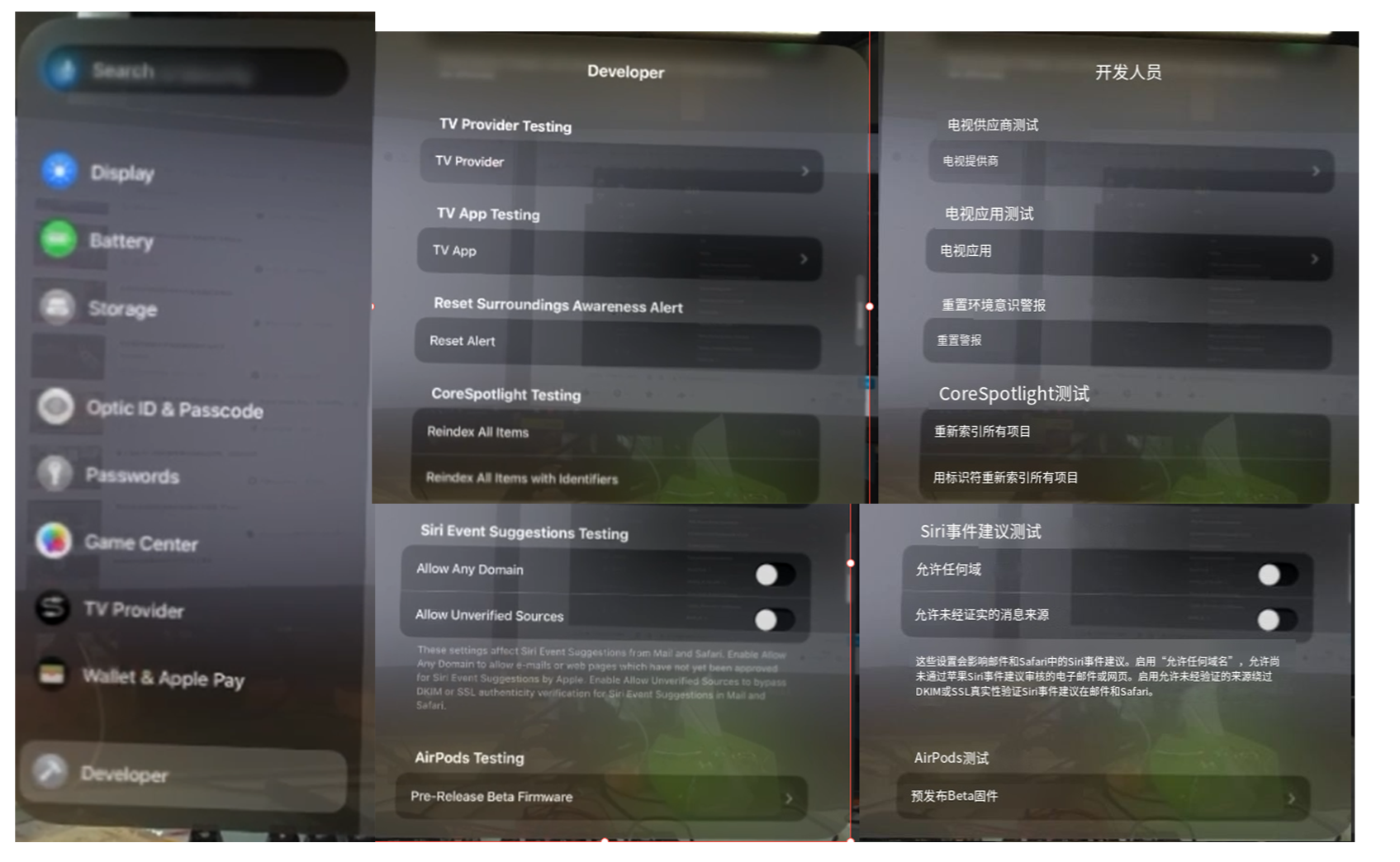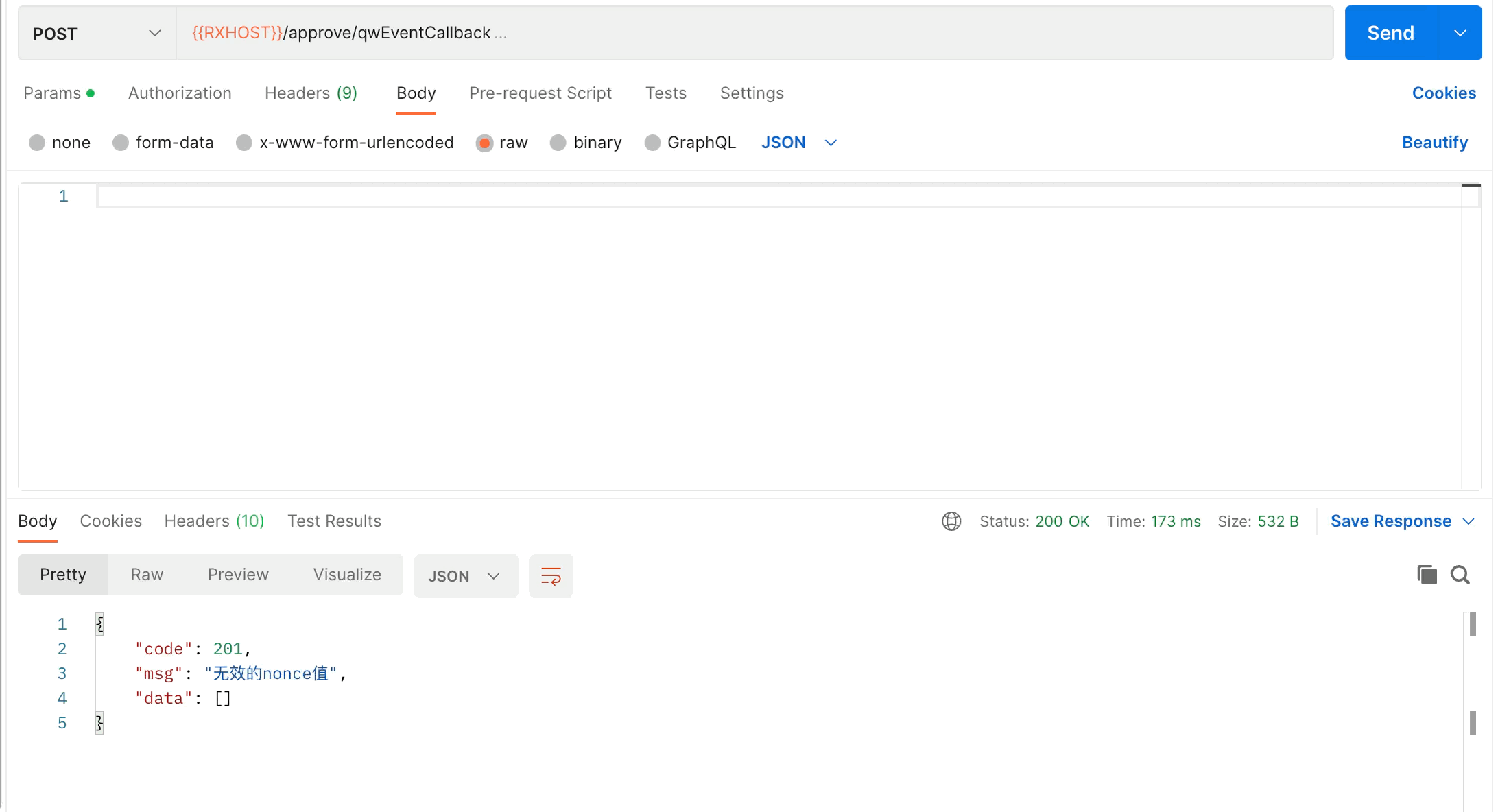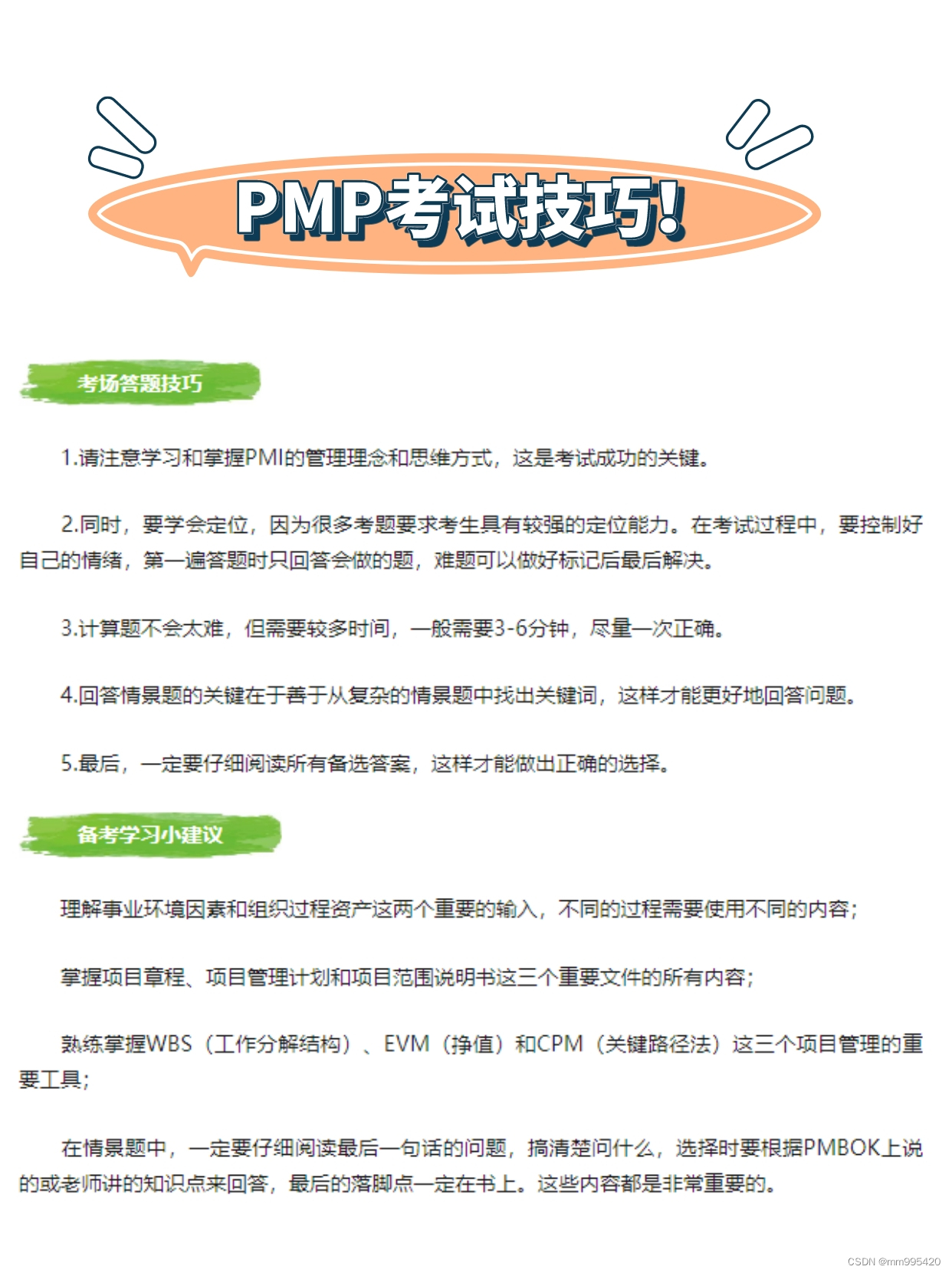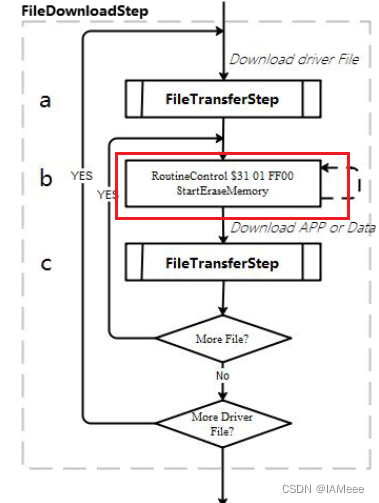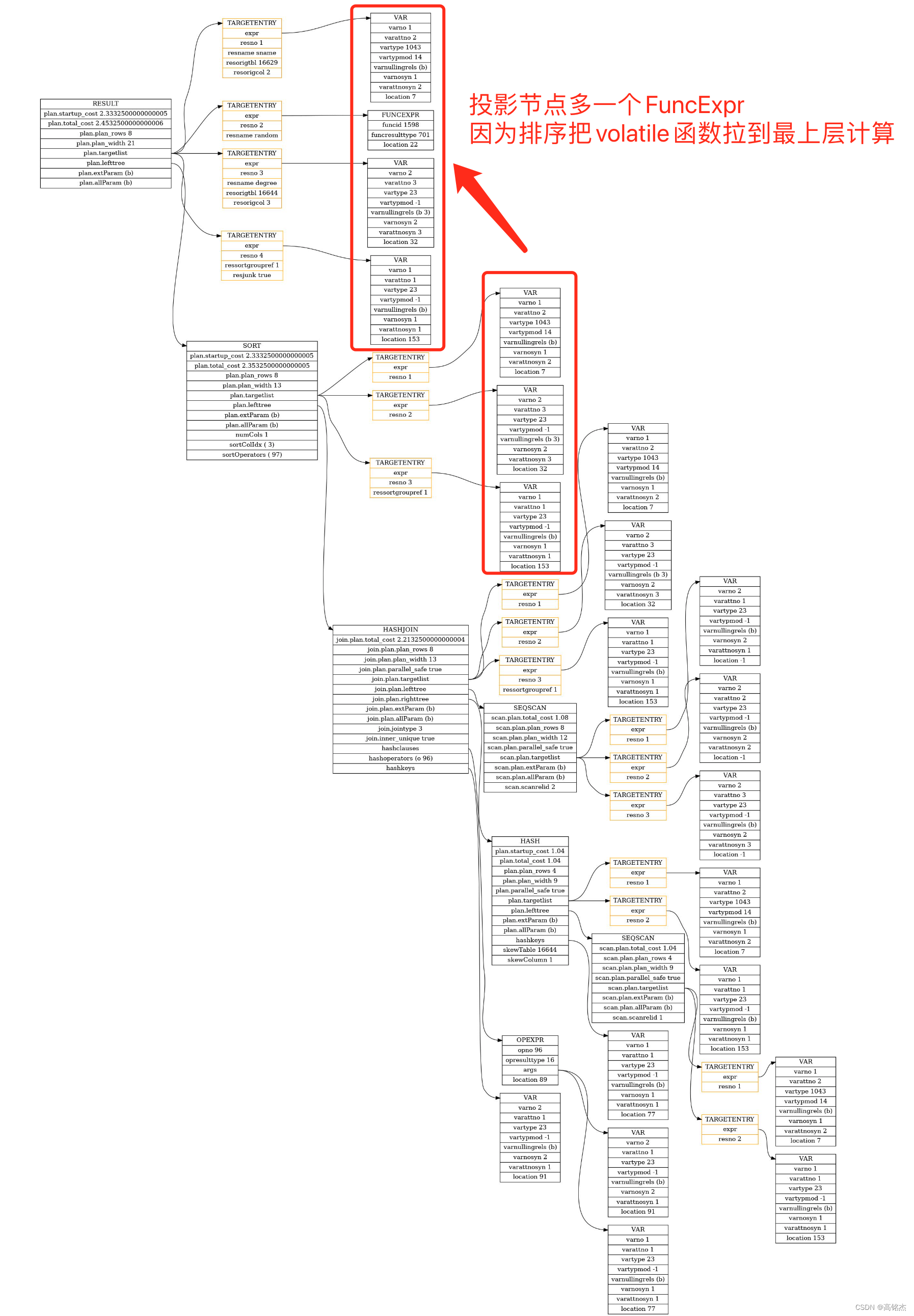系列文章目录
操作系统入门系列-MIT6.S081(操作系统)学习笔记(一)---- 操作系统介绍与接口示例
操作系统入门系列-MIT6.828(操作系统工程)学习笔记(二)----课程实验环境搭建(wsl2+ubuntu+quem+xv6)
操作系统入门系列-MIT6.828(操作系统工程)学习笔记(三)---- xv6初探与实验一(Lab: Xv6 and Unix utilities)
文章目录
- 系列文章目录
- 前言
- 一、xv6文档第一章
- 1. 引论
- 二、实验一
- 1.启动xv6
- 2.实现休眠函数
- 3.实现父子进程pingpong打印
- 4.使用pipeline实现质数检测
- 5.实现find函数(文件查找)
- 6.实现xargs函数
- 总结
前言
MIT 6.828课程资料与进度计划表
完成第一节课的学习后,按照课程的计划进度表,应当阅读xv6文档的第一章节,以及完成实验1。
本文主要内容就是对xv6文档(2023年版)和实验(2023年版)的讲解
xv6英文文档—2023
xv6中文文档—2013
xv6实验1原文
一、xv6文档第一章
1. 引论
xv6操作系统提供 Unix 操作系统中的基本接口(由 Ken Thompson 和 Dennis Ritchie 引入),同时模仿 Unix 的内部设计,包括 BSD,Linux,Mac OS X,Solaris (甚至 Microsoft Windows 在某种程度上)都有类似 Unix 的接口,理解 xv6 是理解这些操作系统的一个良好起点。
首先需要对操作系统有一个系统结构的大致概念,如下图:

如图所示,操作系统的核心就是kernel。kernel起到了桥梁的作用,连接各种应用程序和底层硬件资源。从软件编程者的角度来看,程序员就是使用各种kernel提供的系统调用函数,来实现各种各样的功能。xv6的系统调用函数如下图所示:
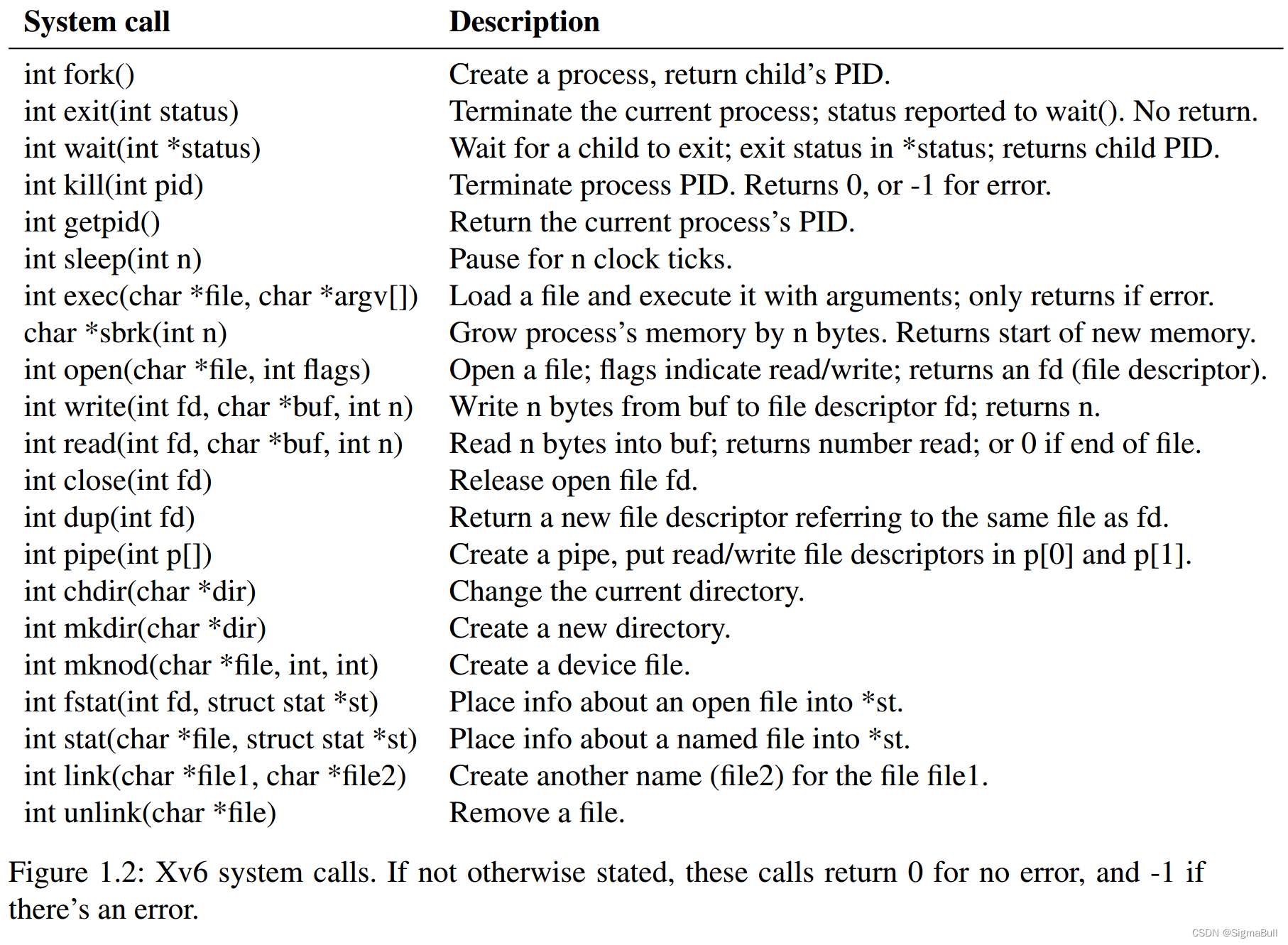
后面的实验就是需要调用这些系统调用函数来实现相应的功能,比如在Linux里面常用的find、xargs等命令的简易版。
在之前的文章中已经将第一章的部分进行了讲解,详情见:
操作系统入门系列-MIT6.S081(操作系统)学习笔记(一)---- 操作系统介绍与接口示例
二、实验一
1.启动xv6
详见xv6环境的配置和启动
操作系统入门系列-MIT6.828(操作系统工程)学习笔记(二)----课程实验环境搭建(wsl2+ubuntu+quem+xv6)
(1)实验系统目录:
整个实验代码的文件目录如下,我们需要关注:
1.绿色的”grade-lab-util“可执行文件,它是测试机,用来测试你的实验代码正确性。
2.kernel文件夹,是xv6的kernel代码
3.Makefile是用来编译内核的,需要在这里添加参数,我们写的实验代码才能编译进去
4.user文件夹是我们添加自己实验代码的地方,也就是用户空间

(2)Makefile添加文件

(3)退出xv6
使用”ctrl+a“,后按x退出
(4)测试机打分
需要在lab目录中添加time.txt文件,里面写一个整数,代表你的实验花了多少小时。

2.实现休眠函数
(1)原题如下:

(2)大致内容为:
调用“系统调用函数——sleep()”(一次sleep()系统暂停一个tick),实现输入数字,系统暂停该数字次数的ticks。
参数错误时,要有错误打印
(3)代码如下:
// 参考echo.c、grep.c、rm.c的头文件引用
#include "kernel/types.h"//声明数据类型
#include "kernel/stat.h"//声明文件数据结构
#include "kernel/fcntl.h"//open函数的模式参数申明
#include "user/user.h"//声明各种系统调用函数、以及有用的库函数
int main(int argc, char *argv[])
{
int number;
//参数数量不对,打印错误信息
//参数还有其他错误情况,此处仅考虑数量问题
if(argc <= 1)
{
fprintf(2, "usage: sleep number\n");
exit(1);
}
number = atoi(argv[1]);//字符串转整数
sleep(number);//系统调用
exit(0);
}
(4)结果如下:
使用官方提供的测试机程序,在lab目录下面运行"./grade-lab-util + 文件名"
./grade-lab-util sleep
测试机自主进行测试,如下图:

(5)总结:
在做实验之前我们需要知道有哪些函数我们是可以调用的,可以查看文件:“user/user.h”
struct stat;
// system calls
int fork(void);
int exit(int) __attribute__((noreturn));
int wait(int*);
int pipe(int*);
int write(int, const void*, int);
int read(int, void*, int);
int close(int);
int kill(int);
int exec(const char*, char**);
int open(const char*, int);
int mknod(const char*, short, short);
int unlink(const char*);
int fstat(int fd, struct stat*);
int link(const char*, const char*);
int mkdir(const char*);
int chdir(const char*);
int dup(int);
int getpid(void);
char* sbrk(int);
int sleep(int);
int uptime(void);
// ulib.c
int stat(const char*, struct stat*);
char* strcpy(char*, const char*);
void *memmove(void*, const void*, int);
char* strchr(const char*, char c);
int strcmp(const char*, const char*);
void fprintf(int, const char*, ...);
void printf(const char*, ...);
char* gets(char*, int max);
uint strlen(const char*);
void* memset(void*, int, uint);
void* malloc(uint);
void free(void*);
int atoi(const char*);
int memcmp(const void *, const void *, uint);
void *memcpy(void *, const void *, uint);
3.实现父子进程pingpong打印
(1)原题如下:

(2)大致内容为:
实现过程:父进程向子进程发送ping,子进程打印该信息,后子进程向父进程发送pong,父进程再打印该信息
实现结果为:

(3)代码如下:
分为单管道实现和双管道实现
单管道实现:
#include "kernel/types.h"
#include "kernel/stat.h"
#include "kernel/fcntl.h"
#include "user/user.h"
int main(int argc, char *argv[])
{
int p[2];
char buf[512];//用来接收信息的buffer
pipe(p);//父 <=======> 子
//子进程执行if,父进程执行else
if(fork() == 0)
{
read(p[0], buf, sizeof(buf));//阻塞,直到父进程写入管道p内容,后读取父进程的信息
fprintf(1,"%d: received %s\n", getpid(), buf);//打印父进程的信息
write(p[1], "pong", 5);//使用p的写通道向父进程发送信息
close(p[0]);//关闭读通道
close(p[1]);//关闭写通道
exit(0);//子进程退出
}
else
{
write(p[1], "ping", 5);//父进程通过p的写通道向子进程发送信息
wait((int *)0);//等待子进程结束
read(p[0], buf, sizeof(buf));//读取p管道中子进程的信息
fprintf(1,"%d: received %s\n", getpid(), buf);//打印子进程的信息
close(p[0]);//关闭读通道
close(p[1]);//关闭写通道
}
exit(0);
}
双管道实现:
#include "kernel/types.h"
#include "kernel/stat.h"
#include "kernel/fcntl.h"
#include "user/user.h"
int main(int argc, char *argv[])
{
int p[2];
int p2[2];
char buf[512];//用来接收信息的buffer
//向内核申请两个管道
pipe(p);//父进程写,子进程读:父 ——————> 子
pipe(p2);//子进程写,父进程读:子 ——————> 父
//子进程执行if,父进程执行else
if(fork() == 0)
{
close(p[1]);//关闭p的写通道,以便于父进程写完可以直接读取
read(p[0], buf, sizeof(buf));//阻塞,直到父进程写入管道p内容,后读取父进程的信息
fprintf(1,"%d: received %s\n", getpid(), buf);//打印父进程的信息
close(p[0]);//关闭p的读通道
write(p2[1], "pong", 5);//使用p2的写通道向父进程发送信息
close(p2[1]);//写完关闭写通道
close(p2[0]);//关闭p2的读通道
exit(0);//子进程退出
}
else
{
write(p[1], "ping", 5);//父进程通过p的写通道向子进程发送信息
close(p[1]);//写完关闭写通道
close(p2[1]);//关闭p2的写通道,以便于子进程写完可以直接读取
read(p2[0], buf, sizeof(buf));//阻塞,直到子进程写入管道p2内容,读取子进程的信息
fprintf(1,"%d: received %s\n", getpid(), buf);//打印子进程的信息
close(p[0]);//关闭p的读通道
close(p2[0]);//关闭p2的读通道
}
exit(0);//结束程序
}
(4)结果如下:

(5)总结:
无
4.使用pipeline实现质数检测
(1)原题如下:

(2)大致内容为:
使用pipeline+多进程来检测35以内的质数检测
这个过程比较难想,但是在纸上推演一下流程就懂了,参考文献如下:Bell Labs and CSP Threads
参考伪代码:
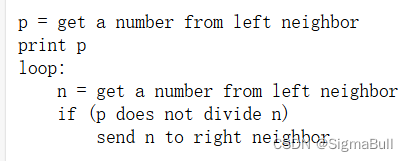
参考图:
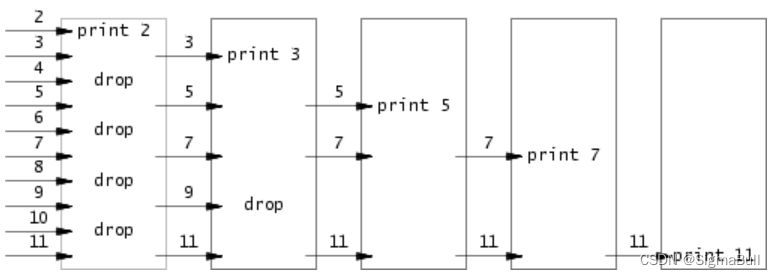
(3)代码如下:
#include "kernel/types.h"
#include "kernel/stat.h"
#include "kernel/fcntl.h"
#include "user/user.h"
void child(int * p)
{
int p1[2];
char num[35];
int prime;
int i;
int ret;
int number;
pipe(p1);
close(p[1]);
number = 0;
for(i=0;i<35;i++)
{
ret = read(p[0], num+i, 1);
if(ret == 0)
{
break;
}
number++;
}
if(number == 0)
{
exit(0);
}
prime = num[0];
printf("prime %d\n", prime);
close(p[0]);
if(fork() == 0)
{
child(p1);
}
else
{
close(p1[0]);
for(i=1;i<number;i++)
{
if((num[i]%prime)!=0)
{
write(p1[1], num+i, 1);
}
}
close(p1[1]);
wait((int *)0);
}
exit(0);
}
int main()
{
int prime = 2;
int p[2];
int i;
pipe(p);
if(fork() == 0)
{
child(p);
}
else
{
close(p[0]);
printf("prime %d\n", prime);
for(i=3;i<=35;i++)
{
if((i%prime)!=0)
{
write(p[1], &i, 1);
}
}
close(p[1]);
wait((int *)0);
}
exit(0);
}
(4)结果如下:

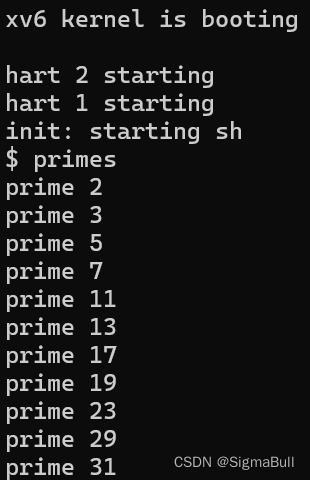
(5)总结:
核心是算法题,载体是进程树之间使用pipeline进行读写控制
5.实现find函数(文件查找)
(1)原题如下:

(2)大致内容为:
实现目录下搜索文件的功能,要求能够找到该文件夹目录下以及其子目录下的指定文件名,输出所有满足文件的路径。(不要求实现正则表达式)(!!!记得规避".“与”…"子文件)(如何访问文件夹可以参考文件ls.c的实现)
" . " 表示当前目录
" .. " 表示当前目录的上一级目录。
" ./ " 表示当前目录下的某个文件或文件夹,视后面跟着的名字而定
" ../ " 表示当前目录上一级目录的文件或文件夹,视后面跟着的名字而定。
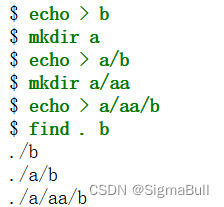
(3)代码如下:
#include "kernel/types.h"
#include "kernel/stat.h"
#include "kernel/fcntl.h"
#include "kernel/fs.h"
#include "user/user.h"
char* fmtname(char *path)
{
char *p;
// Find first character after last slash.
for(p=path+strlen(path); p >= path && *p != '/'; p--)
;
p++;
return p;
}
int find(char *name, char *p)
{
int fd;
int path=0;
char buf[512];
struct dirent de;
struct stat st;
fd = open(p, O_RDONLY);
if(fd < 0)
{
fprintf(2, "fd: can not open %s\n");
exit(1);
}
strcpy(buf, p);
p = buf+strlen(buf);
*p++ = '/';
// printf("%d %s\n", fd, buf);
while(read(fd, &de, sizeof(de)) == sizeof(de))
{
if(de.inum == 0)
{
continue;
}
memmove(p, de.name, DIRSIZ);
p[DIRSIZ] = 0;
// printf("%s\n", p);
if(stat(buf, &st) < 0)
{
printf("ls: cannot stat %s\n", buf);
continue;
}
// printf("%s %s %d\n", buf, fmtname(buf), st.type);
// printf("%d %d %d\n", strcmp(fmtname(buf), name), strcmp(fmtname(buf), "."), strcmp(".", "."));
if (st.type == T_FILE && (strcmp(fmtname(buf), name) == 0))
{
printf("%s\n", buf);
path = 1;
}
if (st.type == T_DIR && (strcmp(fmtname(buf), ".") != 0) && (strcmp(fmtname(buf), "..") != 0))
{
path = find(name, buf);
}
}
return path;
}
int main(int argc, char *argv[])
{
int path;
if(argc < 3)
{
fprintf(2, "fd: find [dir] [filename]\n");
exit(1);
}
path = find(argv[2], argv[1]);
if(path == 0)
{
fprintf(1, "can not find such file\n");
}
exit(0);
}
(4)结果如下:

(5)总结:
核心知识点是xv6系统下的文件结构体与文件夹结构体,使用递归方法进行实现。
6.实现xargs函数
(1)原题如下:
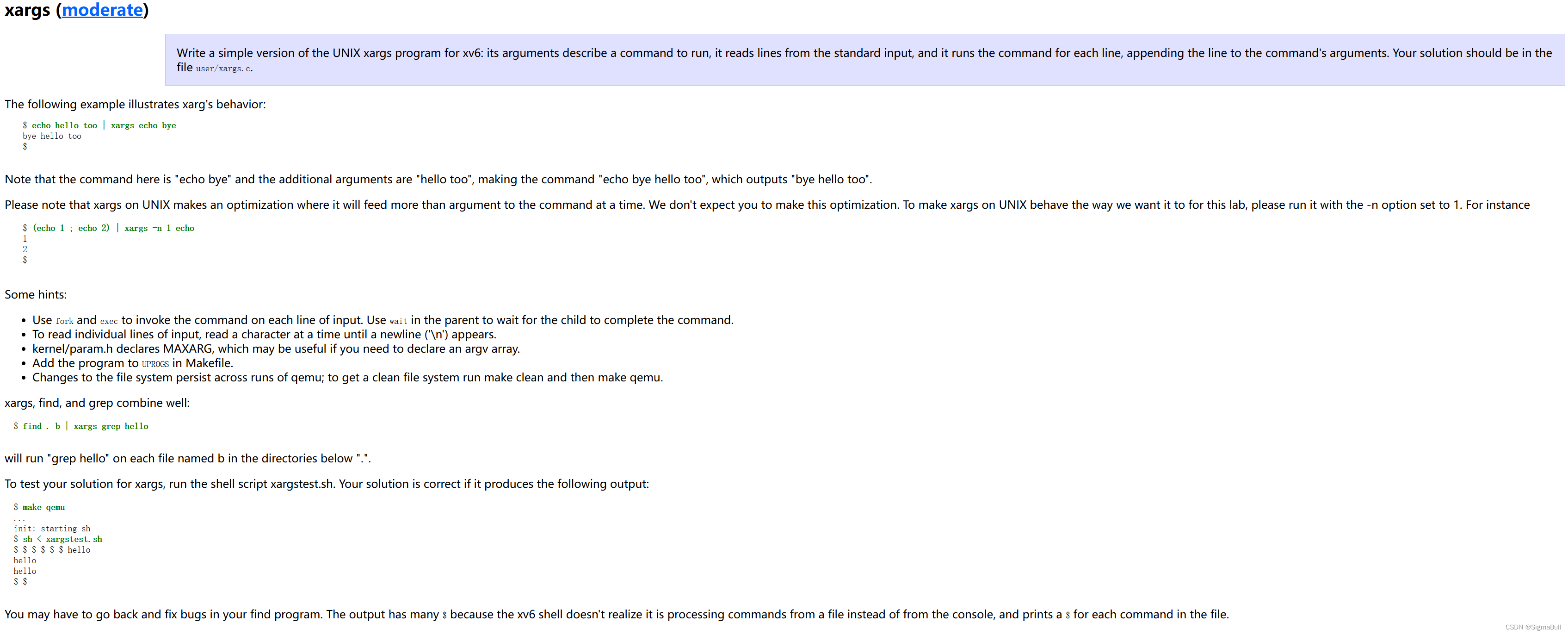
(2)大致内容为:
实现xargs命令,xargs命令很难简单理解,建议先查一下命令的用法。
xargs 命令教程
(3)代码如下:
#include "kernel/types.h"
#include "kernel/stat.h"
#include "kernel/fcntl.h"
#include "user/user.h"
#include "kernel/param.h"
int getcmd(char *buf, char**arg, int arg_num)
{
int i;
int j;
j = 0;
arg[arg_num] = (char *)malloc(30 * sizeof(char));
for(i=0; i<512; i++)
{
if((buf[i] == ' ') || (buf[i] == 10) || (buf[i] == '\0') || (buf[i] == '\n'))
{
// printf("%c %d\n", buf[i], buf[i]);
arg_num++;
if(buf[i] == 10)
{
// printf("argmun: %d\n", arg_num);
return arg_num;
}
if(buf[i] == '\0')
{
// printf("argmun: %d\n", arg_num);
return arg_num;
}
arg[arg_num] = (char *)malloc(30 * sizeof(char));
// printf("111\n");
// printf("%s %p kkk\n", arg[arg_num], arg[arg_num]);
j = 0;
}
else
{
// printf("%d %d %c %d\n", j, i, buf[i], arg[arg_num][j]);
arg[arg_num][j] = buf[i];
// printf("%d %c \n", j, arg[arg_num][j]);
j++;
}
}
return arg_num;
}
int main(int argc, char *argv[])
{
char buf[512];
int num = 0;
int ret;
int cmd = 0;
char *arg[MAXARG];
int arg_num;
arg_num = argc - 1;
int i = 0;
for(i=0; i<arg_num; i++)
{
arg[i] = argv[i+1];
}
if(argc < 2)
{
fprintf(2, "xarg: xarg [process] [args...]\n");
exit(1);
}
int j = 0;
while(1)
{
ret = read(0, buf+j, 1);
if(ret != 1)
{
break;
}
else if(buf[j] == '\n')
{
// printf("read number is : %d\n%s\n", num, buf);
j = 0;
num = 0;
cmd = getcmd(buf, arg, arg_num);
// printf("\n\n%d %d\n", cmd, arg_num);
// printf("%s\n%s\n%s\n%s\n", arg[0], arg[1], arg[2], arg[3]);
if(cmd == arg_num)
{
printf("%d %d\n", cmd, arg_num);
printf("no content of stdin\n");
}
else
{
if(fork() == 0)
{
exec(argv[1], arg);
fprintf(2, "exec failed\n");
exit(1);
}
else
{
wait((int *)0);
}
}
}
else
{
j++;
num++;
}
}
for(i=0; i<cmd; i++)
{
free(arg[i]);
}
exit(0);
}
(4)结果如下:
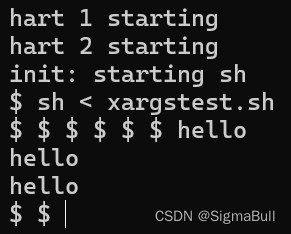
(5)总结:
在实现字符串的单词分割的时候,对于指针的操作出现问题。
char **arg的arg[]元素应该动态分配空间,而不是讲temp数组的指针头直接赋值。
总结
课程每年可能有变化,本文按照最新的2023计划表进行学习

